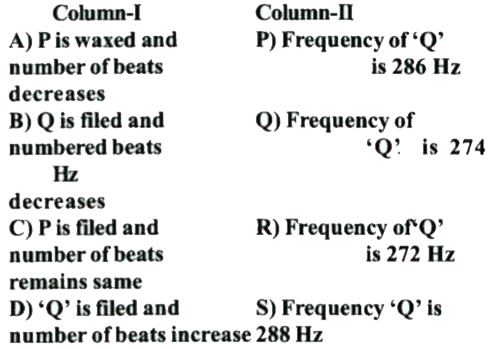A tuning fork of frequency 250 Hz produces a beat frequency of 10 Hz when sounded with a sonometer vibrating in its fundamental frequency. When the tuning fork is filed, the beat frequency decreases. If the length of sonometer wire is 0.5 m, the speed of transverse wave is
260ms−1
250ms−1
240ms−1
500ms−1
The correct Answer is:C
Frequency of sonometer wire =(250+10) or (250−10) and on filing
fbeat↓
∴ frequency of sonometer wire = 240
Now, f=v2L⇒v=240×2×0.5
implies v=240m/s.
Topper's Solved these Questions
- BOOK - ERRORLESSCHAPTER - WAVES AND SOUND EXERCISE - NCERT BASED QUESTIONS (STATIONARY WAVES)10videos
WAVES AND SOUND
- BOOK - ERRORLESSCHAPTER - WAVES AND SOUND EXERCISE - NCERT BASED QUESTIONS (VIBRATION OF STRING)29videos
WAVES AND SOUND
- BOOK - ERRORLESSCHAPTER - WAVES AND SOUND EXERCISE - NCERT BASED QUESTIONS (INTERFERENCE AND SUPERPOSITION OF WAVES)23videos
WAVES AND SOUND
- BOOK - ERRORLESSCHAPTER - UNITS, DIMENSIONS AND MEASUREMENTEXERCISE - ASSERTION & REASON17videos
UNITS, DIMENSIONS AND MEASUREMENT
- BOOK - ERRORLESSCHAPTER - WORK, ENERGY POWER AND COLLISIONEXERCISE - ASSERTION & REASON22videos
WORK, ENERGY POWER AND COLLISION
Similar Questions
Knowledge Check
- Question 1 - Select One
A tuning fork 'P' of frequency 280Hz produces 6 beats/s with unknown tuning fork 'Q'
 AABCDQRSRBABCDQRQPCABCDP.QQ.RR.SPDABCDR.SQ.RSR
AABCDQRSRBABCDQRQPCABCDP.QQ.RR.SPDABCDR.SQ.RSR - Question 2 - Select One
A tuning fork of frequency 500 Hz produces 8 beats/ second when sounded with a having sonometer wire. What must be the frequency of the sonometer wire, if a slight increases be the frequency of the sonometer wire,if a slight increases in its tension produces fewer beats per second that before ?
Aa. 508 HzBb. 492 HzCc. 500 HzDd. 504 Hz - Question 3 - Select One
A tuning fork of frequency 280 Hz produces 10 beats per see when sounded with a vibrating sonometer string. When the tension in the string increases slightly, it produces 11 beats per see. The original frequency of the vibrating sonometer string is :
A269 HzB291 HzC270 HzD290 Hz
A tunnig fork of frequency 256 Hz produces 4 beats per second with a wire of length 25 cm vibrating in its fundamental mode. The beat frequency decreases when the length is slightly shortened. What could be the minimum length by which the wire be shortened so that it produces no beats with the tuning fork ?
View SolutionA tuning fork of frequency 256HZ produces 4 beats per second with a wire of legth 25cm vibrating in its fundamental mode. The beat frequency decrease when the length is slightly shortened. What could be the minimum length by which the wire be shortened so that it produces no beats with the tuning fork?
View Solution(a) A tuning fork produces 4 beats per second with another tuning fork of frequency 256Hz. The first one is now loaded with a little wax and the beat frequency is found to increase to 6 per second. What was the original frequency of the tuning fork ?
(b) A plano wire A vibrates at a fundamental frequncy of 600Hz. A second identical wire B produces 6 betas per second with it, when of the tension in A is slightly increased. Find the ratio of the tension in A to the tension to B.
( c) A tunnig fork if frequency 256Hz produces 4 beats per second with a wire of length 25cm vibrating in its fundamental mode. The beat frequency decreases when the length is slightly shortened. What could be the minimum length by whech the wire be shortened so that it produces no beats with the tuning fork?View SolutionA tuning fork of frequency 480Hz is used to vibrate a sonometer wore having natural frequency 240 Hz. The wire will vibrate with a frequency of
View SolutionA tuning fork of frequency 1024 Hz is used to produce vibrations on a sonometer wire of natural frequency 256 Hz. Then the wire will vibrate in
View Solution

